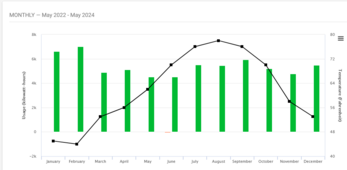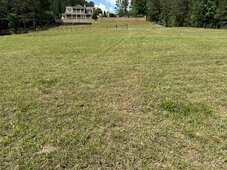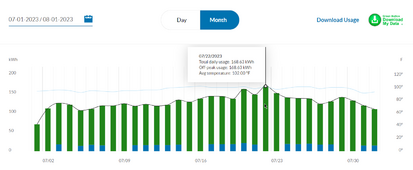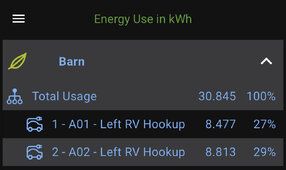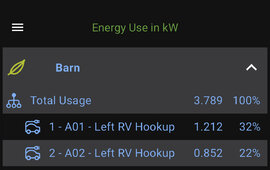AutoMater
New Member
Hello everyone! I am new here!
A friend of mine has been doing some solar on a piece of property he owns and has been sharing his journey. He shared a few of @Will Prowse videos a couple months ago and I have been super interested. So much so that I got in touch with the company that installed a small amount of solar on the house I bought 5 years ago (before I bought it) and had them come out. I took that quote, with their blessing, and shopped for cheaper equipment options, them expecting I would still pay them to help me install all or most of it.
With the advice of my friend I checked out Signature Solar and contacted them to help me design something as well. They suggest EG4 18K's and outdoor batteries (more details later). It is a fraction of the cost of what the local guy quoted and he said he has no problem installing it for me which is cool.
In my highest months I use just short of 8000kWh of power and if I can pull it off (which it looks like I can), I want to find a path to be completely off grid (still grid tie, but not reliant on it). Using used panels and the huge southern facing area I have below a retaining wall I can get more than enough production for my total usage no problem. I have 3 200 Amp Panels in the home and each one will get 1 x 18K to start. The idea then is to use Bus Bars to connect at least 3 of the EG4 PowerPro outdoor batteries and do a master/slave config on the 18K's so they can share all the batteries. This seems to be supported from what I am being told.
Then, over time I can work to 1. Reduce energy consumption where it makes sense and 2. Add batteries over time. Doing both I can "meet in the middle" to achive my goal.
I will likely do more than 3 batteries to begin with, but that is just the general idea - to be setup for expansion and have the ability to keep adding.
A few things I know I need to do:
Get a small roof built off the stone wall where all this will be mounted to keep the sun and rain off of it.
Install Emporia energy monitors in all panels to make sure I am not DRAWING more than 100amp per any panel (If so, I need to add a second 18K to that panel to allow for over 100 amp solar/battery draw)
A few things I want to do / questions:
I would like to figure out how to suggest the local guy builds the frame system for the panels so that I can adjust it up and down per season/month to be at the ideal angle. I have an idea in my head of how this could work but I don't know enough about how they are built to explain it very well. I will try here now in case anyone has any ideas. They hand build it all so I suppose anything is possible.
1. This is not REQUIRED, just seems nice to have.
2. Even if I just had the ability to raise them up and down I could either add the actuators later, or not. I am thinking more about the ability to do.
------------
Do you have any experience with connecting tons of the batteries together with bus bars? Does that make sense? With the master/slave setup I suppose the one 18K will control all the charging (even though that will be coming through all 3 of them). This is the part I would love to hear people's experiences with, if it has been done.
------------
Since the 18K's have generator support I am also thinking of getting at least one generator as a backup in the event it's stormy AND grid power is down (which I suppose is likley to happen at the same time if the grid is down). Any advice on that part? I will have to use propane and can bury a 1000 gallon tank nearby.
------------
Any questions, comments, concerns, advice, etc?
Thanks!!
Craig
A friend of mine has been doing some solar on a piece of property he owns and has been sharing his journey. He shared a few of @Will Prowse videos a couple months ago and I have been super interested. So much so that I got in touch with the company that installed a small amount of solar on the house I bought 5 years ago (before I bought it) and had them come out. I took that quote, with their blessing, and shopped for cheaper equipment options, them expecting I would still pay them to help me install all or most of it.
With the advice of my friend I checked out Signature Solar and contacted them to help me design something as well. They suggest EG4 18K's and outdoor batteries (more details later). It is a fraction of the cost of what the local guy quoted and he said he has no problem installing it for me which is cool.
In my highest months I use just short of 8000kWh of power and if I can pull it off (which it looks like I can), I want to find a path to be completely off grid (still grid tie, but not reliant on it). Using used panels and the huge southern facing area I have below a retaining wall I can get more than enough production for my total usage no problem. I have 3 200 Amp Panels in the home and each one will get 1 x 18K to start. The idea then is to use Bus Bars to connect at least 3 of the EG4 PowerPro outdoor batteries and do a master/slave config on the 18K's so they can share all the batteries. This seems to be supported from what I am being told.
Then, over time I can work to 1. Reduce energy consumption where it makes sense and 2. Add batteries over time. Doing both I can "meet in the middle" to achive my goal.
I will likely do more than 3 batteries to begin with, but that is just the general idea - to be setup for expansion and have the ability to keep adding.
A few things I know I need to do:
Get a small roof built off the stone wall where all this will be mounted to keep the sun and rain off of it.
Install Emporia energy monitors in all panels to make sure I am not DRAWING more than 100amp per any panel (If so, I need to add a second 18K to that panel to allow for over 100 amp solar/battery draw)
A few things I want to do / questions:
I would like to figure out how to suggest the local guy builds the frame system for the panels so that I can adjust it up and down per season/month to be at the ideal angle. I have an idea in my head of how this could work but I don't know enough about how they are built to explain it very well. I will try here now in case anyone has any ideas. They hand build it all so I suppose anything is possible.
- Build the main frame that includes the concrete and all base members as they normally would. Build this at the lowest angle needed for my area.
- Build another rectangle made from the same material that the panels will mount to.
- Place that on top of what they built in step 1.
- Hinge it at the bottom.
- If it just lays there, it is at the lowest angle, but if I began to "lift it" from the rear, I could achieve other angles.
- From there, I could either have fixed angle iron piece to keep it at those levels, or I could use some sort of actuator to raise it up or down
- I am big into home automation so it would be simple for me to cause the actuators to move up and down as I wanted them to. I could even move them daily - whatever made the most sense. I didn't think of this till now but if there was a storm or a lot of wind I could even have it auto put them to their lowest setting.
- I imagine having horizontal 5 panels high (about 20') and 6' wide. I will have about 110 panels so I would have to do this 22 times.
1. This is not REQUIRED, just seems nice to have.
2. Even if I just had the ability to raise them up and down I could either add the actuators later, or not. I am thinking more about the ability to do.
------------
Do you have any experience with connecting tons of the batteries together with bus bars? Does that make sense? With the master/slave setup I suppose the one 18K will control all the charging (even though that will be coming through all 3 of them). This is the part I would love to hear people's experiences with, if it has been done.
------------
Since the 18K's have generator support I am also thinking of getting at least one generator as a backup in the event it's stormy AND grid power is down (which I suppose is likley to happen at the same time if the grid is down). Any advice on that part? I will have to use propane and can bury a 1000 gallon tank nearby.
------------
Any questions, comments, concerns, advice, etc?
Thanks!!
Craig




